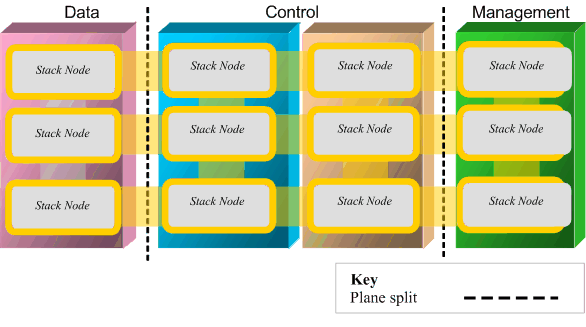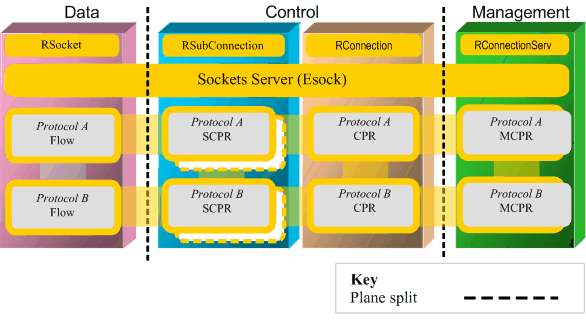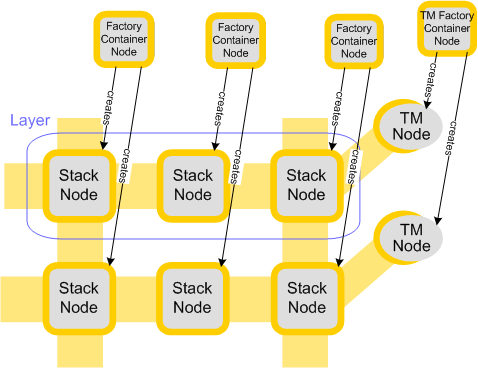Nodes in the Communications Framework
This topic describes the concept of a Node in the Communications Framework.
The Communications Framework separates its implementation into horizontal and vertical divisions - the concept of Layers and Planes. Each of the separate entities is a Node . These entities form part of the Communications stack and are named Stack Nodes . Stack Nodes belong to a single Layer and a single Plane. Stack Nodes also provide Access Point services.
Stack Nodes
There are four Stack Nodes:
MetaConnection Provider (MCPR) Node
The MCPR Node uses the configuration and policy specifications to manage the Layer. A phone creator can replace this Node. The replacement or the configuration of this Node allows a phone creator to change the configuration of the Communications Infrastructure without a change to the software.
Connection Provider (CPR) Node
The CPR Node manages the connections.
SubConnection Provider (SCPR) Node
The SCPR Node manages the subconnections. Each subconnection represents a logical data channel. The Communications Framework has the concept of a default subconnection. A default SCPR always exists to represent the default subconnection. A connection uses the default subconnection if a subconnection is not specified.
Flow Node
The Flow Node manages the data stream.
Each type of Node is related to a specific Plane in the Comms Stack. The following diagram shows that:
-
the Flow Node has a one-to-one relationship with the Data Plane.
-
the MCPR (MetaConnection Provider) Node has a one-to-one relationship with the Management Plane.
-
the Control Plane contains both the SCPR Node and the CPR Node .
-
the SCPR Node can have many instances in operation at the same time.
-
the MCPR Node can connect to resources outside the Communications stack. The offset grey box around the text MCPR represents this fact.
Other Nodes
The Communications Framework has two other types of Node: Tier Manager and Factory Container .
Tier manager Node
A Tier is an alternative to Access Points. A Tier gives users a different method to access the services of the Communications Infrastructure. A Tier represents a higher level communications technology or a collection of technologies. Each communications technology belongs to a Tier, but a Tier can contain more than one technology. When a user selects a technology, a Tier shows the appropriate group of technologies from which the user can select. The Tier handles the selection of the Access Point. A Tier manager Node manages each Tier in the Communications Framework.
Factory Container Node
Factory Containers create Nodes. The Communications Framework supplies a Factory Container for each type of Node. The Factory Containers have published addresses and Nodes use these addresses to find and communicate with the Factory Containers. A Node can create another Node. A Node sends a request to the correct Factory Container to create the other Node. The Factory Container tries to create the new Node and reports status to the Node that made the request.
The following diagram shows the connection between the Stack Nodes and the Tier Manager and Factory Container Nodes.
Copyright ©2010 Nokia Corporation and/or its subsidiary(-ies).
All rights
reserved. Unless otherwise stated, these materials are provided under the terms of the Eclipse Public License
v1.0.


